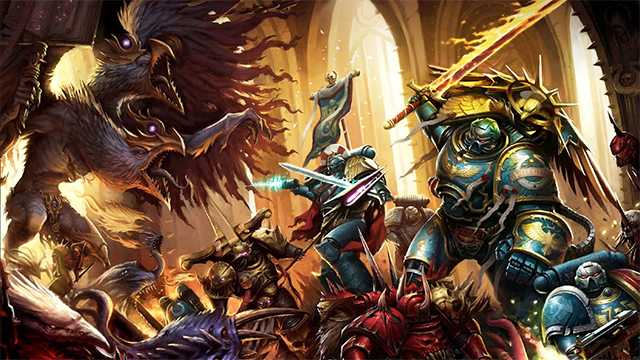In the grim darkness of the far future, there is only this beginner’s guide to starting Warhammer 40K. If you’ve been secretly eyeing up those beautiful little plastic soldiers in the window of your local Games Workshop then this is the guide for you. This is Warhammer 40K beginner’s guide should help you figure out why you should start collecting 40K and will also help you get the most bang for your buck with your opening purchases.
Warhammer 40K Beginner’s Guide: What is Warhammer 40K?
Warhammer 40K is a tabletop miniature game produced by Games Workshop. You buy, assemble, and paint your army of miniature soldiers and then do battle with your friends across the strategically vital battlefield that is your dining room table. The 40K part of the name refers to the game’s setting—the far-flung future of the 41st millennium. Here genetically engineered super-soldiers battle against the innumerable hordes of aliens and heretics that besiege the Imperium of Man in a never-ending battle for supremacy.
The 8th Edition of Warhammer 40K was released in 2017 to almost universal praise from fans and critics. Bringing a streamlined ruleset and a host of new models to paint and battle with, 8th Edition has revitalized the game and brought a ton of new players into the fold, along with a lot of lapsed fans from the past. This fantastic new ruleset, combined with a Games Workshop who appear to be listening to their fanbase for the first time in decades, means there has never been a better time to start collecting Warhammer 40K.
A word of warning for anyone seriously considering starting the hobby though: it’s not cheap. We can show you great deals and the box sets that offer the best value, but ultimately, you’re going to be spending a decent chunk of money on tiny plastic soldiers. They don’t call it the “plastic crack” for nothing—Warhammer 40K is a rich person’s vice.
Warhammer 40K Beginner’s Guide: Starter Boxes
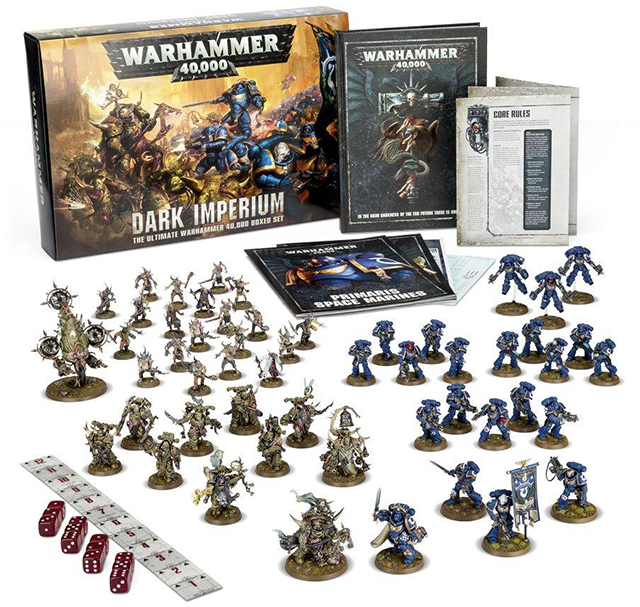
Alongside the revamped rules in the 8th Edition, Games Workshop has been firing out fantastic quality starter boxes which offer exceptional value for new players looking to pick up the hobby. These box sets contain the basic rules for the game and two decent sized starter armies. This already gives you a ton of options out of the gate: you can keep both forces for yourself, sell the half of the box you don’t want, or even split the cost of the box with a friend and take one army each. It’s a two player game after all and you’re going to need someone to play against eventually.
The Starter Boxes all retail at $150 to $160, but you can easily find them cheaper on third-party gaming sites such as The War Store, who offer up to a 20 percent discount on most Games Workshop products. So, you’re more realistically looking at around $130 for an absolute boatload of plastic and a huge saving over the cost of buying the units individually. Because they all come with some unique models that can’t be bought separately, it’s hard to accurately break down the savings you make on these box sets. But you’re easily looking at over $200 worth of miniatures here.
Dark Imperium was the first box set to launch during the 8th Edition of Warhammer 40K and remains the only one that comes with a hardcover copy of the main rulebook. All the other starter sets contain a condensed version of the rules that will certainly get you started, but if you’re looking for the full hardback ruleset, Dark Imperium is the way to go. Alongside the rulebook, you also get two sizable starter forces for the Space Marines and the Death Guard. Space Marines, the poster boys for Warhammer 40K, are genetically engineered super soldiers who battle against the foes of mankind. The Death Guard are their corrupted brothers, traitor Space Marines who now pledge themselves to Nurgle, the Chaos God of Decay.
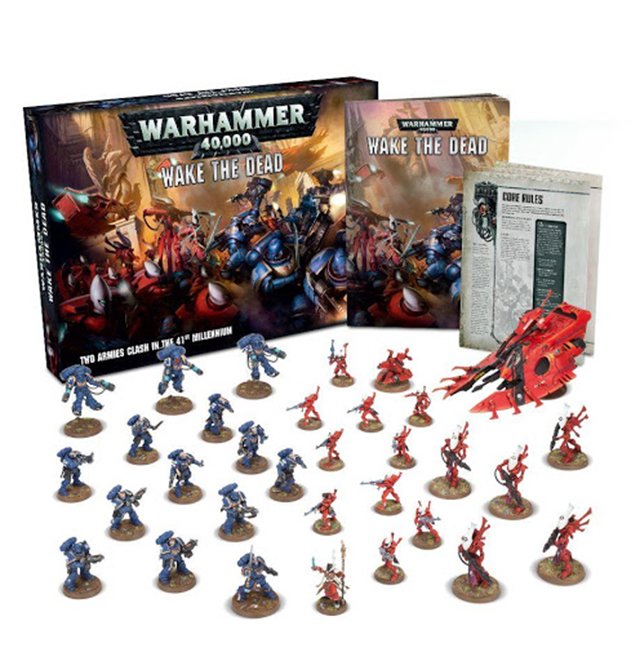
If neither of those armies takes your fancy then there are three other box sets on offer: “Forgebane,” “Tooth and Claw,” and “Wake the Dead.” If you’re seeking out some sweet robot-on-robot action then ‘Forgebane’ is the box for you, pitting the soulless forces of Necrons against the Adeptus Mechanicus, a bizarre cult of humans who worship machines.
Or perhaps you were looking at the Space Marines in “Dark Imperium” and thinking “those, but hairier.” Well, good news my strange friend, because “Tooth and Claw” features the Space Wolves, an offshoot of the Space Marines who are basically power-armored werewolves as they battle the insidious forces of the Genestealer Cults. Finally, “Wake the Dead” brings yet more Space Marines to the party, but this time facing off against the enigmatic Aeldari, a dwindling race who used to rule the galaxy but now struggle to survive.
Warhammer 40K Beginner’s Guide: ‘Start Collecting!’ Boxes
The Starter Boxes offer amazing value, but what if you don’t want to collect any of the armies on offer in these sets? That’s where the “Start Collecting!” boxes come into play.
Retailing at $85, these boxes are available for almost every faction in the game and contain several units for your army, bundled together at a reduced cost. You’re not getting the same kind of savings as you’ll find in the Starter Boxes, but there is a hefty discount on offer in these sets.
Take the “Start Collecting! Tyranids” box, as an example, which contains eight Genestealers, a Broodlord, and a Trygon. Bought separately, those models would set you back $127.75 at RRP so you’re making a healthy saving there and don’t forget that you can get most Games Workshop products even cheaper through third-party retailers, so in reality, you can grab a “Start Collecting!” box for $72.25. As a great man once said, “I punch those numbers into my calculator, it makes a happy face.”
Warhammer 40K Beginner’s Guide: Cheap and Cheerful
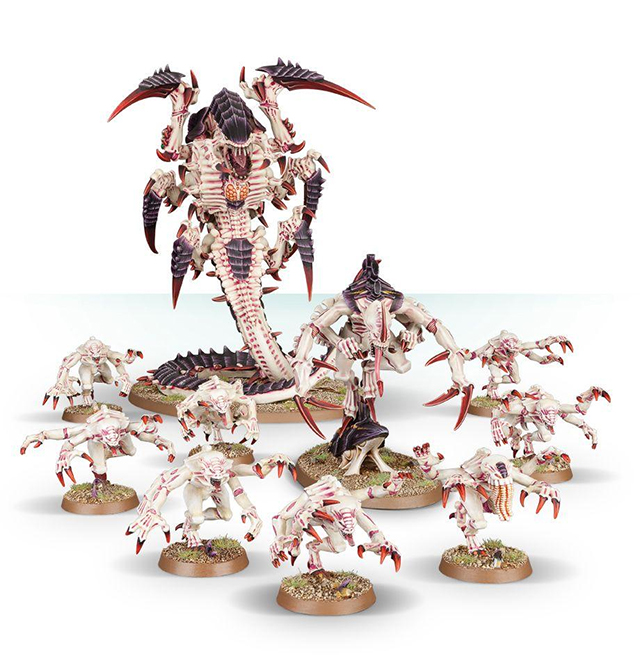
If you’re on the fence about starting the hobby and don’t want to sink any serious cash into it, then there is one more option to consider, the “First Strike” starter set. This little kit costs $40 and contains 15 easy-to-build, push-fit miniatures, some cardboard terrain, and everything you’ll need to play the game (dice, a ruler, and a rules pamphlet). It’s not going to provide you with much of a start on a full army, but “First Strike” is the cheapest, quickest way to get into 40K and see what’s what.
Warhammer 40K Beginner’s Guide: Paints and Glue
Now you’ve got your army selected and you know what models you’ll be bringing home, you’ll need the tools to build and paint them. On the building front, you’ll need a set of clippers and a craft knife for cutting the plastic pieces from the frames, and then some glue to actually build the models. You might also want to invest in a mold line remover which, as the name suggests, a tool used to scrape unsightly plastic mold lines from the models.
On the glue front, you’ll want to start with plastic glue, given that almost all of Games Workshop’s products are plastic. Super glue and PVA glue also have their uses when dealing with basing materials or resin models, but the plastic glue will see you right at first.
When it comes to painting your miniatures, I would not recommend any of the painting starter kits on offer. Not because they’re not good value, but because they tend to offer a wide but shallow color palette. What I mean by this is that a typical starter paint kit will contain one shade of red, one green, one blue, etc. This seems logical, but unless you want your army looking like an Andy Warhol painting, you’re much better off picking out your own paints to build up a paint scheme.
If you want to paint your army up like the box art, then 40K boxes come with a paint guide on the back cover, which shows exactly what paints you need to replicate their scheme. If you’d rather paint them up in a different scheme, then you’ll need to do some research and figure out what paints you’ll need. In general, you’ll need a spray primer, a few base colors for your miniature, and then some highlights and washes to bring the details to life. Oh, and some paint brushes. Those are, as you might guess, pretty important.
If you’re looking for inspiration or tutorials on painting, then Google and YouTube are your friends. There are literally thousands of articles and video tutorials out there, including the official Warhammer TV YouTube channel.
Warhammer 40K Beginner’s Guide: The Stuff You Need to Play the Game
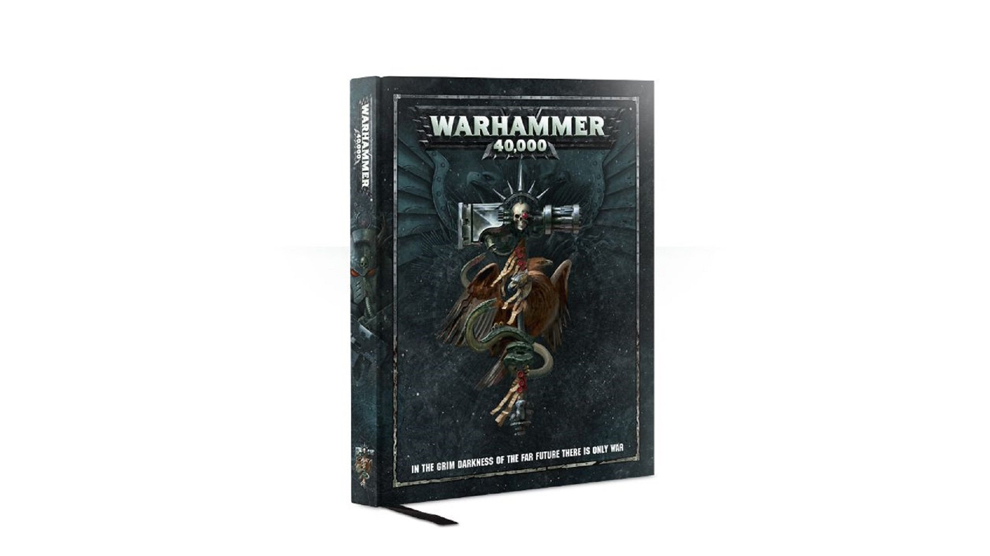
But wait, there’s more. You’ve got all the models and the tools to build and paint them, but you’ll need a few extra bits and bobs if you actually want to play a game of Warhammer 40K. If you purchased one of the starter boxes then you might have everything you need to get started already, but otherwise, you’ll need the main rulebook, your army’s Codex, a bunch of dice, and a measuring device of some sort.
The rulebook covers the core mechanics of the game, along with a bunch of interesting scenarios and game types to try out along with a ton of lore and backstory for the 40K universe, so this really is essential Alongside that, the Codex’s are the individual army books, which delves deeper into the lore of that specific faction and provide all the stats and rules for your models. A tape measure is the ideal measuring device and you can find them pretty cheap in your local hardware store. Finally, 40K is a game of dice so you’re going to need a good collection of those. Games Workshop sells some very ornate and very expensive army-specific themed dice, but otherwise, a big box of dice shouldn’t set you back more than a couple of quid.
OK, that’s it. Your bank account can stop crying now, the punishment is over. You should have everything you need to get you started with Warhammer 40K. Go forth and build your tiny forces of destruction. We look forward to seeing you on the tabletop.
Links:
Dark Imperium:
Forgebane:
- Games Workshop ($160)
- Not available at The War Store
Tooth and Claw:
Wake the Dead:
First Strike:
